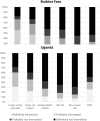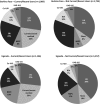Potential user interest in new long-acting contraceptives: Results from a mixed methods study in Burkina Faso and Uganda
- PMID: 31136612
- PMCID: PMC6538161
- DOI: 10.1371/journal.pone.0217333
Potential user interest in new long-acting contraceptives: Results from a mixed methods study in Burkina Faso and Uganda
Erratum in
-
Correction: Potential user interest in new long-acting contraceptives: Results from a mixed methods study in Burkina Faso and Uganda.PLoS One. 2019 Sep 23;14(9):e0223090. doi: 10.1371/journal.pone.0223090. eCollection 2019. PLoS One. 2019. PMID: 31545845 Free PMC article.
Abstract
Method-related concerns represent an important cause of contraceptive non-use and discontinuation. User preferences must be incorporated into the design of new contraceptive technologies to ensure product success and improve family planning outcomes. We assessed preferences among potential users in Burkina Faso and Uganda for six contraceptive methods currently under development or ready for introduction: a new copper intra-uterine device (IUD), a levonorgestrel intra-uterine system, a new single-rod implant, a biodegradable implant, a longer-acting injectable, and a method of non-surgical permanent contraception. Questions were added to nationally-representative PMA2020 household surveys that asked 2,743 and 2,403 women in Burkina Faso and Uganda, respectively, their interest in using each new method. We assessed factors associated with interest through multivariable logistic regression models. We conducted qualitative interviews and focus groups with 398 women, 78 men, and 52 family planning providers and key informants to explore perceived advantages and disadvantages of the methods. Respondents expressed interest in using all new methods, with greatest interest in the longer-acting injectable (77% in Burkina Faso, 61% in Uganda), followed by a new single-rod implant. Least interest was expressed in a new copper IUD (26% Burkina Faso, 15% in Uganda). In both countries, women with less education had higher odds of interest in a longer-acting injectable. Interest in most new methods was associated with desiring a method lasting longer than one year and acceptance of lack of menstrual bleeding as a contraceptive side effect. Perceived advantages and disadvantages were similar between countries, including concerns about menstrual side effects and fear of the biodegradable nature of the biodegradable implant. Potential users, their partners, and providers are interested in new longer-acting methods, however, familiar forms including the injectable and implant may be the most immediately acceptable. A biodegradable implant will require clear counseling messages to allay potential fears.
Conflict of interest statement
The authors have declared that no competing interests exist.
Figures
References
-
- Centers for Disease Control and Prevention. Ten great public health achievements—United States, 1900–1999. MMWR Morb Mortal Wkly Rep. 1999;48: 241–3. Available: http://www.ncbi.nlm.nih.gov/pubmed/10220250 - PubMed
Publication types
MeSH terms
Substances
LinkOut - more resources
Full Text Sources
Medical




